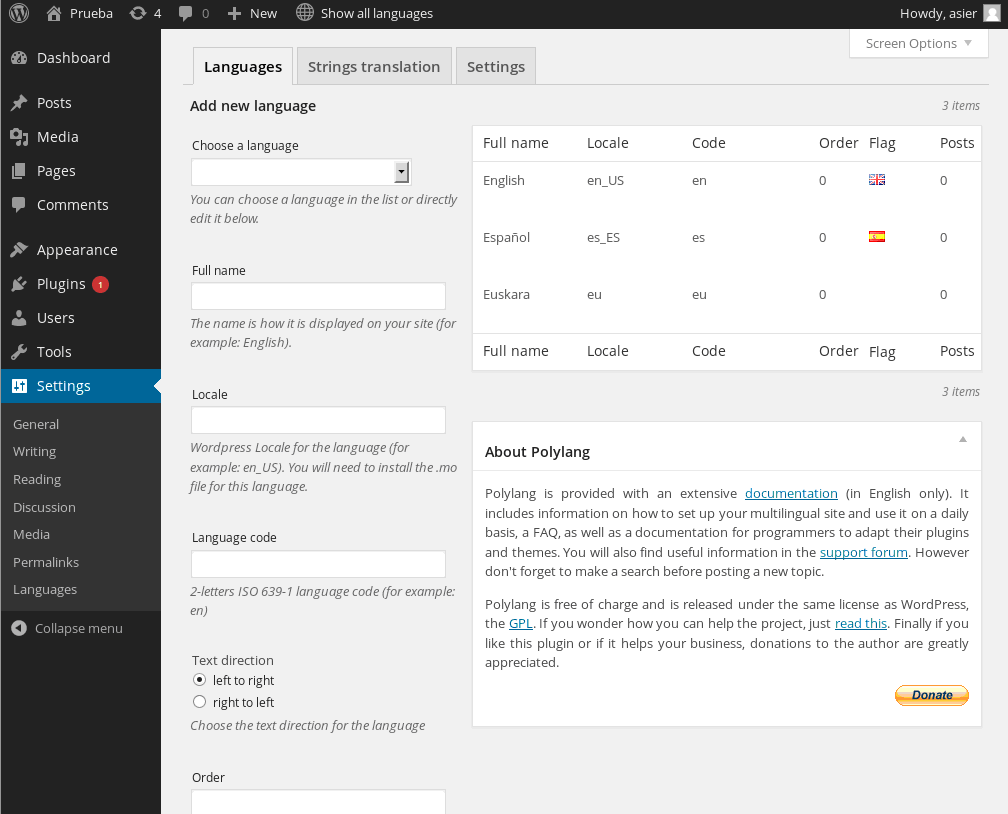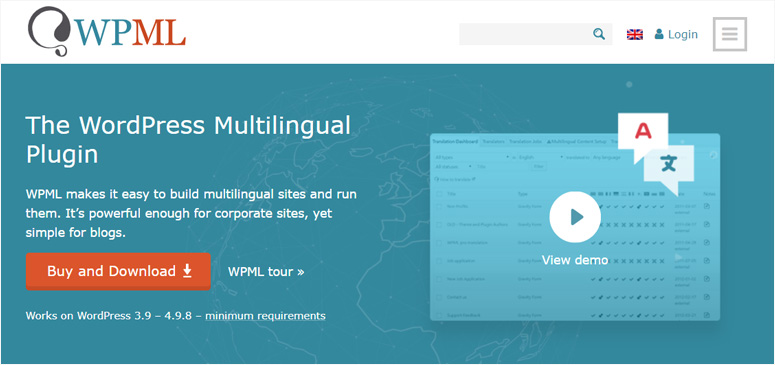Polylang Wordpress
The most important part of our job is to provide support to our customers. This quite often requires that we obtain some technical informations about the WordPress and Polylang configurations. You certainly remember that WordPress recently introduced the Site Health page, available via Tools > Site Health, to display debugging information and test results which helps the support teams to achieve this goal. Polylang now uses this tool to run its own check (testing that the homepage is correctly translated in all languages) and to display various information about the plugin options and languages.
Polylang allows you to create a bilingual or multilingual WordPress site. You write posts, pages and create categories and post tags as usual, and then define the language for each of them. The translation of a post, whether it is in the default language or not, is optional. Getting Started. Polylang advanced. Polylang for WooCommerce. Pre sales questions. Please enable JavaScript in your browser to enjoy WordPress.com.
Returns either the full name, or the WordPress locale (just as the WordPress core function ‘getlocale’ or the slug ( 2-letters code) of the current language. Pllgetpost Returns the post (or page) translation. To install Polylang, follow the usual steps to install a plugin from the wordpress.org repository. To install Polylang Pro, Download polylang-pro.zip by following the link in your purchase receipt or from your account Downloads tab. In your WordPress Dashboard.
Some customers told us that it wasn’t easy to read the language from a post when the posts list table displays all posts in all languages. We heard these remarks and the previous “check-sign” icon has been replaced by the flag corresponding to the post’s language. Hopefully, this will make the language of a post easier to discover. Note that if you decided not to assign any flag to your languages, the language code is displayed instead.
The upcoming version 5.5 will include sitemaps directly in the WordPress core. This requires some adaptation of our plugin and Polylang 2.8 should be ready for this feature.
Polylang Pro will come with a new block which will display a language switcher. It will work exactly as the language switcher widget does since the earliest Polylang versions, but the feature is now directly accessible from your block library, under the widgets category.
Finally I would like to highlight a quite significant change for developpers. Up to now, we used not to filter some WP_Query made for the backend or the REST requests. This was the case when the query included some specific query vars directly specifying posts or terms (for example: ‘post__in’, ‘page_id’, ‘tag’… Here is the complete list). We ended up to realize that this was a pretty wrong idea which caused several conflicts. Thus, starting from the version 2.8, all the WP_Query will be filtered by default. It’s of course always possible to disable any language filter by including an empty ‘lang’ in the WP_Query arguments. Also, nothing changes on frontend, as the query is still auto-translated to return only posts in the current language.
You can test the release candidate version of Polylang 2.8 as of today, together with WordPress 5.5 RC1 to test the sitemaps. Polylang Pro 2.8 RC1 can be downloaded from your account. The free version is available on wordpress.org. Please test it and report bugs on GitHub.
WordPress 5.5 is planned for August, 11th and will come with several new features impacting Polylang, including the sitemaps but not only. Polylang 2.8 is planned for the next week. We recommend to wait for Polylang 2.8 before updating to WordPress 5.5.
Picture illustrating the article by Free-Photos and licensed under the Pixabay license.
Description
Features
Polylang allows you to create a bilingual or multilingual WordPress site. You write posts, pages and create categories and post tags as usual, and then define the language for each of them. The translation of a post, whether it is in the default language or not, is optional.
- You can use as many languages as you want. RTL language scripts are supported. WordPress languages packs are automatically downloaded and updated.
- You can translate posts, pages, media, categories, post tags, menus, widgets…
- Custom post types, custom taxonomies, sticky posts and post formats, RSS feeds and all default WordPress widgets are supported.
- The language is either set by the content or by the language code in url, or you can use one different subdomain or domain per language
- Categories, post tags as well as some other metas are automatically copied when adding a new post or page translation
- A customizable language switcher is provided as a widget or in the nav menu
Polylang Wordpress Menu
The author does not provide support on the wordpress.org forum. Support and extra features are available to Polylang Pro users.
If you wish to migrate from WPML, you can use the plugin WPML to Polylang
If you wish to use a professional or automatic translation service, you can install Lingotek Translation, as an addon of Polylang. Lingotek offers a complete translation management system which provides services such as translation memory or semi-automated translation processes (e.g. machine translation > human translation > legal review).
Credits
Thanks a lot to all translators who help translating Polylang.
Thanks a lot to Alex Lopez for the design of the logo.
Most of the flags included with Polylang are coming from famfamfam and are public domain.
Wherever third party code has been used, credit has been given in the code’s comments.
Do you like Polylang?
Don’t hesitate to give your feedback.
Polylang Wordpress Plugin
Installation
- Make sure you are using WordPress 5.1 or later and that your server is running PHP 5.6 or later (same requirement as WordPress itself)
- If you tried other multilingual plugins, deactivate them before activating Polylang, otherwise, you may get unexpected results!
- Install and activate the plugin as usual from the ‘Plugins’ menu in WordPress.
- Go to the languages settings page and create the languages you need
- Add the ‘language switcher’ widget to let your visitors switch the language.
- Take care that your theme must come with the corresponding .mo files (Polylang automatically downloads them when they are available for themes and plugins in this repository). If your theme is not internationalized yet, please refer to the Theme Handbook or ask the theme author to internationalize it.
FAQ
Where to find help ?
- First time users should read Polylang – Getting started, which explains the basics with a lot of screenshots.
- Read the documentation. It includes a FAQ and the documentation for developers.
- Search the community support forum. You will probably find your answer here.
- Read the sticky posts in the community support forum.
- If you still have a problem, open a new thread in the community support forum.
- Polylang Pro users have access to our helpdesk.

Is Polylang compatible with WooCommerce?
- You need a separate addon to make Polylang and WooCommerce work together. A Premium addon is available.

Do you need translation services?
- If you want to use professional or automatic translation services, install and activate the Lingotek Translation plugin.
Reviews
